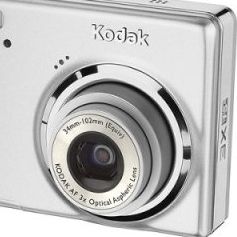Hard on the heals of Kodak’s M863, which we tested a few weeks back, the M893 IS offers a very similar specification in a very similar body size and style too. A stylish, lightweight snapper it feels rather plasticy; it’s equipped with a decent resolution at 8.1-megapixels that Kodak claims is enough for prints up to 30 x 40-inches. Well yes, in theory.
Our quick take
The Kodak EasyShare M893 IS provides nice features within a tidy, pocketable design but image noise and sluggish performance don’t do it any favours.
If you are after a reasonable snapper and you’ll print images at modest sizes you’ll be happy, but don’t buy this camera if it is 30 x 40-inch prints you’ll be wanting on a regular basis, as it might just leaving feeling disappointed.

Kodak EasyShare M893 IS - 3.5 / 5
| FOR | AGAINST |
|---|---|
|
|
But as with the M863, higher sensitivities selected from the camera’s ISO 80 to ISO 1600 range simply create too much noise but thankfully, the auto ISO mode auto limits the ISO available from ISO 80 to ISO 400. Prints or images shot over ISO 400 and at that large size are heavily stippled with distracting noise; the higher the sensitivity the worse it becomes.
Add the fact the noise processing starts to strip away detail too and then the print quality (at that large size) becomes even worse. It’s a good thing then that the M893 IS has an ace up it’s metaphorical sleeve: optical image stabilisation.
The obvious benefit here is that low light images without flash at lower sensitivities or shots taken at longer zoom ratios on the M893 IS’ neat, 3x (34-102mm) optical zoom lens are not ruined by camera shake/hand wobble.
But the key here is the level of extra control this offers for larger prints: it means you can shoot using lower ISO settings, getting the best quality out of the sensor and image processing for better print quality.
Other key features include the Face AF system that suffers from the usual problems of not recognising a face in profile but otherwise works well. Kodak’s Perfect Touch processing allows you to process images in-camera from the memory card and even up highlights and shadows to pull out more detail and helping to sort colour issues as well.
You can save a "Perfectly Touched" image as a new file on the camera’s storage (32MB of internal storage is included or it will accept SD/SDHC external storage) in use or overwrite the original file with the processed image. It’s not quite up to the standard of Nikon’s D-Lighting processing and cannot be applied to the images as they’re taken. However, at this price it’s a nice feature to have within the camera’s armoury.
In terms of handling, the camera features the usual array of shutter release, flash button, and on/off control on the top plate. The screen, which becomes very hard to see in bright daylight and has an overly reflective surface, takes up most of the back plate with the lens zoom, menu, a dedicated delete button and a mode dial that is so small it’s very fiddly to use.
These controls sit above a four-way jog button and a screen toggle button. At the very bottom sits the Share button that allows you to print or even email the images using email addresses you’ve imported in to the camera from a PC.
The camera’s scene modes, of which you get 18 to play with including portrait, panorama, landscape and night scene settings, among others, provide a good selection of modes for oft-used subjects. A high ISO mode can be helpful preventing subject blur (particularly in conjunction with the anti-shake system to prevent camera shake) but with the caveat, you’ll get loads of noise and not be able to print at very large sizes.
640 x 480-video recording with sound is included (incidentally, you can also add sound clips to images as well) but only at 15fps, so video looks jerky, which is a shame. A modest macro mode is included but bafflingly, the closest focus distance claimed in the spec is 2.3-inches but the closest achieved on test (either at the wide or zoomed ends of the lens) was around 5 inches.
The performance is best summed up with one word: sluggish! Focusing is slow, even Face AF, this gets worse once the flash is activated as you’ll need to wait for the flash to charge up and for any pre-flash to fire before the pictures taken, particularly when using the red eye reduction mode.
And so, the Kodak EasyShare M893 IS is a camera designed to offer a respectable set of features at a competitive price and that it does well, particularly the CCD-shift Image Stabilisation. However, once you try to pull more from it, be it performance but particularly if larger prints are required, the problems inherent in such a camera become obvious.
To recap
The Kodak EasyShare M893 IS provides nice features within a tidy, pocketable design but image noise and sluggish performance don’t do it any favours
